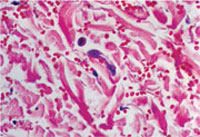|
| Fig. 33.2 Larva currens. Biopsy demonstrates migrating larva of Strongyloides stercoralis in the dermis. (Courtesy of the Fitzsimons Army Medical Center teaching files.) |
Larva currens, or “racing larva,” is caused by
Strongyloides stercoralis, a nematode with a normal life cycle similar to the hookworm.
Strongyloides, however, is unique in that it can complete its life cycle within the human host and bypass the obligate soil phase of the hookworms. Autoinfection may occur to a point of overwhelming infestation and host death, especially in immunocompromised victims. The serpentine eruption of larva currens appears much the same as creeping eruption but is more likely to occur on the thighs, buttocks, or perineum due to larval penetration from the nearby colon. The eruption is more fleeting and lasts no more than a few days, during which the larva’s migratory speed through the dermis may be clocked at up to 10 cm/hr (Fig. 33-2). A nonspecific rash or hives may also occur because of hypersensitivity to the parasite.
